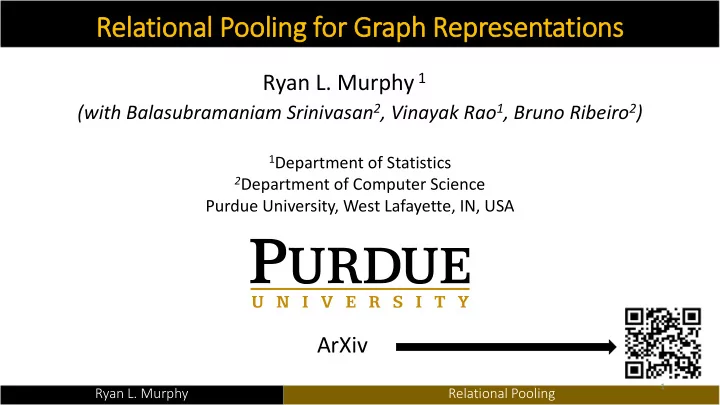

Relational Pooling for Graph Representations Ryan L. Murphy 1 (with Balasubramaniam Srinivasan 2 , Vinayak Rao 1 , Bruno Ribeiro 2 ) 1 Department of Statistics 2 Department of Computer Science Purdue University, West Lafayette, IN, USA ArXiv 1 Ryan L. Murphy Relational Pooling
Learning Graph Representations • A graph representation function 𝑔 maps graphs to real-valued vectors › Graphs can have vertex/edge features • Example: representations for end-to-end supervised learning on graphs 𝑔 𝒊 ∈ ℝ 𝑒 Use 𝒊 to predict properties ՜ of the molecules 𝑔 𝒊 ∈ ℝ 𝑒 ՜ 2 Ryan L. Murphy Relational Pooling
Permutation-Invariance of f Learned Representations • An adjacency matrix 𝑩 in the data is not the only valid such matrix, any permuted version, denoted 𝑩 (𝜌) , is also valid 3 Ryan L. Murphy Relational Pooling
Current Representations are Lim imited • Example: For GNNs, a current state-of-the-art for learning permutation-invariant representations, we have: Theorem:(Xu et al. 2019, Morris et al. 2019): WL[1] GNNs are no more powerful than the Weisfeiler-Lehman (WL) algorithm for graph isomorphism testing. • WL[1] GNNs can’t perform CSL task: › Cycle graphs with skip links of length 𝑆 › Task: given graph, predict 𝑆 › WL[1] GNNs fails • Relational Pooling will help overcome such limitations 4 Ryan L. Murphy Relational Pooling
Ӗ Relational Pooling • Given graph 𝐻 = (𝑩, 𝒀) with 𝑜 vertices, where rows of 𝒀 are node attributes 𝑔 𝑩, 𝒀 = 1 𝑔(𝑩 𝜌 , 𝒀 (𝜌) ) Ԧ 𝑜! 𝜌 Any permutation-sensitive graph function Theorem 2. 1: RP is universal graph representation if Ԧ 𝑔 is expressive enough. • RP is a most-powerful representation • but intractable, must be approximated 5 Ryan L. Murphy Relational Pooling
A A Case-Study: Making GNNs more expressive • Define a permutation-sensitive GNN (1) add unique IDs as node features (2) run any GNN RP-GNN: sum over all permutations of IDs Theorem 2. 2: RP-GNN is more powerful than state-of-the-art GNNs Ryan L. Murphy Relational Pooling 6
: stochastic optimization ( 𝜌 -SGD) One tractability approach : • At each epoch, just sample one set of permutation-sensitive IDs • CSL task w/ 10 classes (graphs with 41 vertices), RP-GNN * to predict the class • We also observed promising results wrapping RP around GNNs for molecules • Take home: adding stochastic positional IDs is a simple way to make GNNs more powerful! *state-of-the-art Graph Isomorphism Network of Xu et. al. 2019 7 Ryan L. Murphy Relational Pooling
Approximate Permutation-Invariance • Estimating most-expressive RP with tractability strategies is only approximately permutation-invariant • But learning more expressive models approximately opens up interesting new research directions 8 Ryan L. Murphy Relational Pooling
Summary ry • RP provides most-expressive representations, learned approximately › Promising new research direction • Our poster includes details on › more tractability strategies › choices for Ԧ 𝑔 , like CNNs and RNNs , now valid under RP Poster: Relational Pooling for Graph Representations, Today 06:30 -- 09:00 PM Pacific Ballroom #174 ArXiv 9 Ryan L. Murphy Relational Pooling
Recommend
More recommend